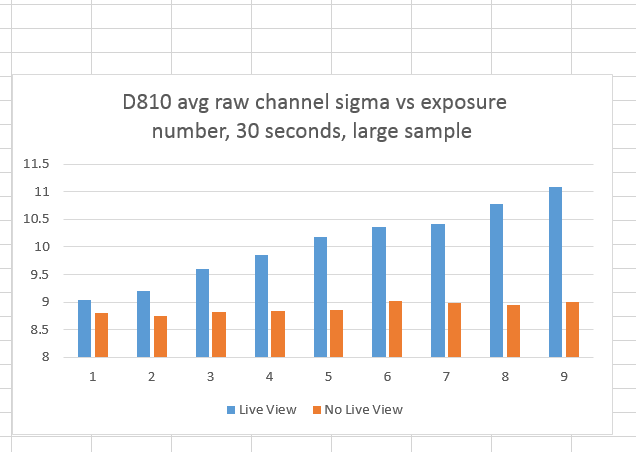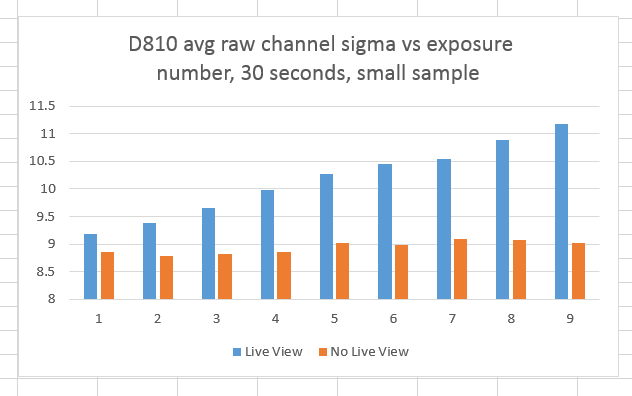A few days ago, I posted some graphs that indicated that using live view on the D810 had no material effect on dark-field noise at 1/2000 second shutter speeds. Yesterday, I repeated the tests at 1/30 second and 1 second shutter speeds, with similar results.
I’ve received a request to do more testing at really long shutter speeds. 30 second is as long as the D810 will do without special tricks, so that’s what I picked.
Here’s the protocol. In a 68-degree F (20 degrees Celsius) room, I set a D810 up in manual mode, with 14 bit raw file precision. I set the ISO to 800, which is the highest ISO on the D810 where there is no clipping of dark-field images. I set the shutter to EFCS at 30 seconds, the aperture to f/16, the shutter mode to single shot, and the exposure delay to 0. With the lens cap on, I made a series of several exposures with live view off, starting each exposure immediately after the preceding one ended. I shut the camera off for half an hour, then I made another series about a minute apart with live view on. Thus, in the second series, live view was on for 30 seconds, then the shutter was open for 30 seconds.
I analysed the files in RawDigger, both for almost the entire frame, and for a 200×200 central area, averaging the standard deviation of the captures for all four raw channels.
The results:
The effect of the heating induced by the use of live view on the dark field noise is greater than at slower shutter speeds, but it is certainly not dramatic. In fact, I consider it fairly small.
There appears to be virtually no self-heating-induced increases in dark field noise from simply having the shutter open and the sensor collecting light for ling periods of time.


Many thanks Jim,
It confirms my tests. With higher ISO you have to be careful, take in consideration. And with long exposure to think about for noise and detail affection.
Thanks!
JG
You should probably plot those with a logarithmic Y axis.
You are correct, but the range is so small it wouldn’t make much difference.
FYI – A minor typo in the following D810 posts
http://blog.kasson.com/?p=8940
http://blog.kasson.com/?p=8977
http://blog.kasson.com/?p=8985
“I set a D810 up in manual mode, with 14 bit raw file precision. I set the ISO to 800, which is the highest ISO on the D800 where there is no clipping of dark-field images.”
D810 in 1st sentence changes to D800 in 2nd sentence.
Keep up the good work.
Fixed. Thanks!